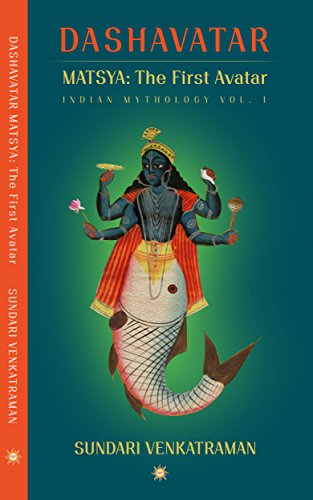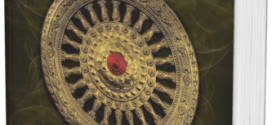What makes us, human beings, a very special species?
Our ability to think, speak, read, write and preserve the knowledge that could be pass on through generations, right?
That gave birth to civilizations and cultures.
This Is Here In For You
Listen To The Podcast:
If you love to listen to the book review over reading, or if you want to go through it while doing other activity, here is our Podcast of this review article. Do listen, and share your thoughts with us.
Spotify:
YouTube:
Being the culturally rich civilizaiton, the Indian culture has a compendium of tales, fables, lore, spiritual and wisdom books and much more. You may look at these literary gems from the spectacle you want, but, you cannot ignore its impact on building morals, ethics and preserving and transferring knowledge through generations.
One of the interesting set of tales explores – Dashavatar. As the name suggests it talks about the 10 avatars, Lord Vishnu takes to reestablish the righteousness or Dharma.
You can say, he follows his promise:
यदा यदा ही धर्मस्य ग्लानिर्भवति भारत।
अभ्युथानम् अधर्मस्य तदात्मानं सृजाम्यहम्॥
परित्राणाय साधूनां विनाशाय च दुष्कृताम्।
धर्मसंस्थापनार्थाय संभवामि युगे-युगे॥
The holy trinity – Brhama, Vishnu and Mahesh – all have their specific set of tasks distributed amongst them. While Brahma is responsible for the creation and Mahesh (aka Shiva) invokes destruction to clear the path for the new beginning, new creation; Vishnu is responsible for well-being (yoga-kshem) of all the species through the cycle. He thus needs to take various avatars, as per the need of time, to set up the order in the society. As per the scriptures, the following are the ten “avatar”s of him.
मत्स्य कुर्मो वराहश्च नरसिन्होथ वामन।
रामो रामश्च क्रुश्नश्च् बुद्ध: कल्कि च ते दश:।।
If you look at the chronology of these avatars from a logical and scientific perspective, you can also see the evolution of species clearly. However, today we are going to look at them from kids’ literature perspective.
| Book Title | : | Matsya: The First Avatar Dashavatar - 1 |
| Author | : | Sundari Venkatraman |
| Published by | : | Flaming Sun (Indie published) ( 11 March 2018) |
| # of Pages | : | 37; 687 KB (Kindle EBook) |
| # of Chapters | : | 6 |
| Purchase Link(s) | : |
Recently, we got a chance to read Dashavatar – series by author Sundari Venkatraman. These book fall in kids-special literature category.
Today we are going to talk about the first book in the series – Matsya: The First Avatar.
Book Cover:
Being a gateway to the virtual world explored within, the cover page is responsible for the first impression of the book. And, thus it can influence a remarkable number of purchase and/or read decisions for sure.
Let us take a look at the cover page of this book.

Matsya: The First Avatar (Dashavatar Book 1) By Sundari Venkatraman | Book Cover
The light to dark gradient of green color from the center to outward gives it a calm look. In the center you can see the illustration of Lord Vishnu in his traditionally worshiped – Chaturbhuj – pose with all the hands are full with respective elements – emerging from a fish’ (Matsya) mouth.
As you can see, it is not very attractive but faithful-to-the-story cover.
The Book And What I Think Of It:
Usually we talk about a book in two distinguished segments, dedicated to the book story and our views for the same respectively.
I will try to avoid as many spoilers as possible, but, I need to quote some elements from the book to give you a fair idea about the quality of content, so you, yourself can decide whether it is something you enjoy reading. So, some spoilers might be there. So, please read with the consent.
This is a very short book (37 pages) and the author has focused on communicating her thoughts in easy language. It works pretty well for the target readers. It is worth to note that this book is self-published by the author under the banner – Flaming Sun.
We often miss reading acknowledgements and preface sections, as usually, they are not directly related to the content of the book, directly. However, I personally suggest you to not to miss those segments. They not only give you a glance of the author’s thought process behind seeding of the book, but also, lets you explore a different side of his/her personal.
For example, the author comes from a family of traditional values and has a special bond with her grandparents. It emphasise the “traditional growing up” in Bharatiya culture where kids used to hear a story from either of his/her grandparents when trying to fall asleep at night. The author must have had such growing up – as she dedicate this book to her parents and grandparents.
The author introduces the reader to the cycle of yugas and creation/destruction and re-creation in simple words. Then comes the exploration of how the current universe came to existence. I like the way she introduces the legendary characters to the reader.
The exhausted Brahma, despite his ability to see in all directions, didn’t notice the Asura Hayagriva who was eyeing him from far away Earth. Hayagriva, the asura with the head of a horse and the body of a man, was built like a small mountain.
Simple, crisp, meaningful and convincing, right?!
But that doesn’t mean the author doesn’t explore something relatable, especially by the target readers, the kids and young adults of current time. For example:
The sea close to that area contained fresh water due the melting of the icebergs and hence helped quench the asura’s thirst only too well.
The ancient Indian scriptures talks about many creation/recreation cycles and thus the stories often look like they are having overlapping timelines. You need to dig deeper in the stories to understand them quite well. Also understand that different versions of the stories across various geographical regions are popular. Even while reading this book, you can see some words written as they are pronounced in the southern India. For example:
Sathya Yuga
King Satyavrath
Of course, there are words like Ajneya chakra which could have been written better.
The author doesn’t let a chance to elaborate wordplays go when the opportunity is there 🙂 For example:
Blood poured from both of them, turning the blue waters into the colour of the setting sun.
The story of Vedas and Hayagriva, how the apocalypse was scheduled and how Lord Matsya guided the king to save the species, maybe already known to you, and if not, better to read the book and explore them.
Another positive aspect of the book is its – Glossary – segment.
I liked reading this small, interesting book.
On a side note, if you are a Kindle Unlimited subscriber, you can read it for free – as of now. So, don’t miss the chance :).
Summary:
The book hits the bull’s eye for the target readers. It introduces the readers to Matsya-avatar in quite an interesting way. Definitely, must read, for the young adults who are not much familiar with the tale.
ThinkerViews Rating:
I would give it around 7.5 stars out of 10.
Quick Purchase Links:
- Buy - Matsya: The First Avatar by Sundari Venkatraman - Kindle EBook - Amazon IN
- Buy - Matsya: The First Avatar by Sundari Venkatraman - Kindle EBook - Amazon US
Over To You:
If you already have read the book do share your remarks and thoughts via comments below. Does this review help you in making your decision to buy or read the book? Do not forget to share this article with your friends over various social networks. Please follow/subscribe us on various Social networks like Twitter, Facebook, YouTube, Spotify, Amazon Prime Music, Audible, and others. And yes, you may like to subscribe to our RSS feeds to get latest updates for the site to land right in your mail box.
 ThinkerViews – Views And Reviews Personal views and reviews for books, magazines, tv serials, movies, websites, technical stuff and more.
ThinkerViews – Views And Reviews Personal views and reviews for books, magazines, tv serials, movies, websites, technical stuff and more.



